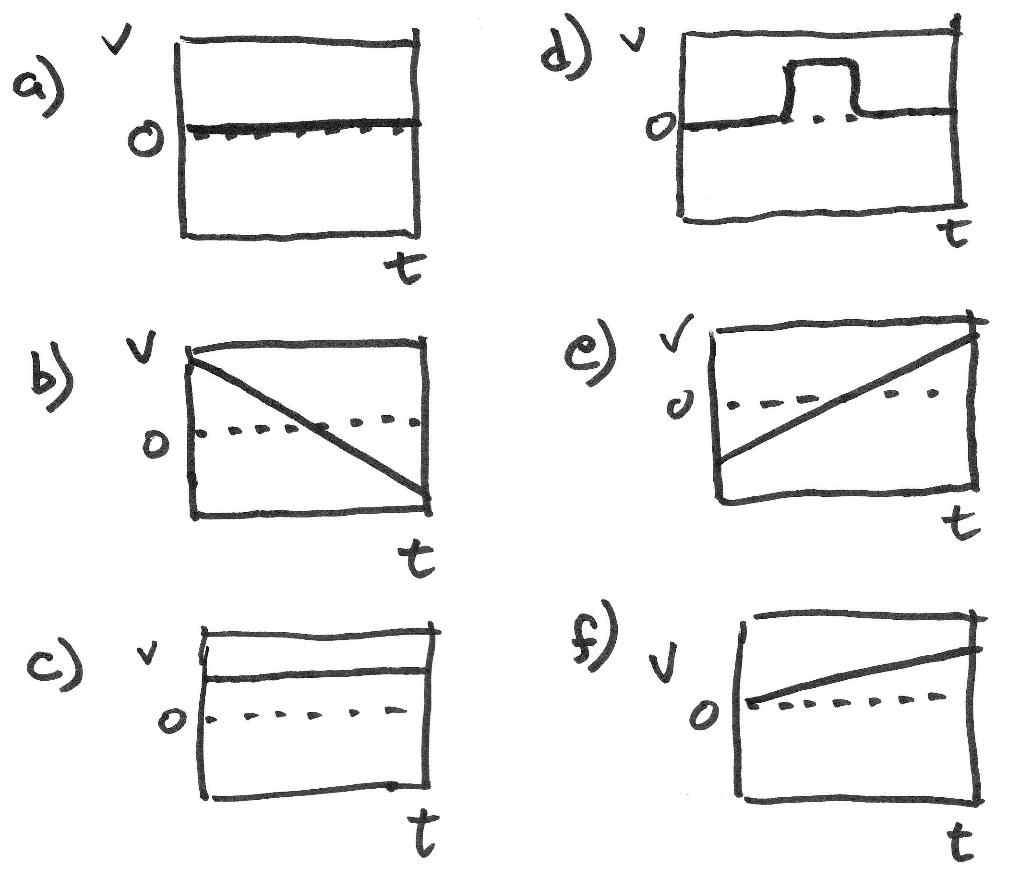Chapter2Problems
Copyright © 2016 McGraw-Hill Education. All rights reserved. No reproduction or distribution without the prior written consent of McGraw-Hill Education.
CHAPTER2.CHAPTER2PROBLEMS
1. Whatisthecontacttimebetweenthepuckandthestickinexample ??? 2.5
×= 495%2
Vx - 24.6 %
0.05 s = 50 ms
Copyright © 2016 McGraw-Hill Education. All rights reserved. No reproduction or distribution without the prior written consent of McGraw-Hill Education.
2. Infigure2.1,arunner’spositionisplottedasafunctionoftime.
(a)Graphicallyestimatehervelocityatt=3seconds.
(b)Forthewholerun,whatisheraveragespeed,inm/s?
(c)Ontwogrids,roughlysketchherspeedasafunctionoftimeand heraccelerationasafunctionoftime.Includenumbersontheaxes.
(d)IsthisrunnearOlympicstandards?
slope Vx skepgeinmmiddloemofracei_3Om-01m-5.EFfs.IEtx.om@a.5msbsux.t
3. Abaseballisthrownstraightupwithavelocityof30m/s.Indicating boththemagnitudeanddirectionofthevelocity...
a)whatistheball’svelocitytwosecondsafterbeingthrown?
b)4secondsafterbeingthrown?
4. Arunnerismovingat5m/satt=2s,andbyt=5s,shemovesat11 m/sinthesamedirection.Whatisheraverageacceleration?
Copyright © 2016 McGraw-Hill Education. All rights reserved. No reproduction or distribution without the prior written consent of McGraw-Hill Education.
5. Alotofconfusionabout“floating”comesfromthefactthatabig jumperspendssomuchtimeneartheverypeakofhisjump.
a)Ifabasketballplayerjumps36inchesstraightup,forhowlongis heintheair?
b)Forhowlongishewithin9inchesofthetopofhisjump?
c)Whatfractionofthetimeisheinthetop900 ?
b) easiest way : consider the time it takes to fall 9 inches , and double that C it's also the Same as Thang for 9 inches , but that's not always obvious to students )
6. L.A.DodgerscenterfielderMattKempisoneofthefastestplayersin baseballtoday,nearthetopofstolenbaselists.He’sbeenclockedat 22mph,nottoofarfromBolt’speakspeed,showninfigure ??.Kemp roundssecondandisracingtowardsthirdat24mph.
a)Ifhemaintainsaconstantspeed,howlongdoesittakeforhimto coverthefinal12feettothird?
b)Ofcourse,cominginto3rd baseatfullspeedmeansthattherunner willlikelyoverrunthebase.Therefore,thebasecoachsignalsKemp toslidethefinal12feet.Hedoesso,deceleratingataconstantrate, comingtorestpreciselyonthebase.Whatisthemagnitudeofhis acceleration?Howdoesthiscomparetotheaccelerationduetogravity?
c)Bysliding,howmuchmoretimehasKemptakentoreachthebag? I.e.howlongdoesittakehimtocoverthefinal120 whensliding,and howdoesthatcomparewithyouranswertopart(a)?
7. Adistancerunnercompletesonemilein5minutes.Whatishisaverage velocity,inm/s?
8. AFerrariScagliettihasanaccelerationof5.9m/s2 ,whichweassume constant.Howfardownthetrackhasitgone,5secondsafterit’s jumpedo↵ thestartingline?
9. Whenanobjectacceleratesat9 8m/s2 (or32ft/s2 ),wesayitaccelerateswithone“gee”(g ).Thisistruewhethertheobjectisfallingunder gravity,orduetosomethingelse.Usingtheconstant-accelerationapproximationwe’vediscussedinthischapter,howmany“gee’s”describe thefollowingsituations?
(a)CedarPoint’sTopThrillDragster(anawesomeride,bytheway): Accordingtothepark,itgoes0-120mphin3.8secondsonthehorizontaltrack,beforeturningupvertically.
(b)Afootballkicko↵:Theballisinitiallyatrestonthetee.Afterbeingincontactwiththekicker’sfootforonly8ms,itleavesthekicker’s footat85ft/sec.
10. Ontheleftinfigure2.2arefoursketchedgraphsofpositionversus time.
(a)Whichvelocity-versus-timegraph(ontheright)correspondswith eachposition-versus-timegraph?
(b)Whichofthevelocity-versus-timeplot(s)couldcorrespondtomotionunderaconstant,non-zeroacceleration? Write a, b c d, e, f, or NONE




Figure2.2:Problem10.
Copyright © 2016 McGraw-Hill Education. All rights reserved. No reproduction or distribution without the prior written consent of McGraw-Hill Education.
11. Unawarethatyouhavetakenaphysicsclass,amajorleaguepitcher claimsthathecanthrowabaseballfromtheground,straightupas highastheEmpireStateBuilding,whichis1250feettall.
(a)Atwhatspeedwouldhehavetothrowtheball,toaccomplishthis?
(b)Approximatelyhowfast can amajorleaguepitcherthrowaball?
(c)Usingyouranswerfrompart(b),howhighwouldtheballgo,if thrownstraightup?
12. Therearemanylegendsofbasketballplayerswith2-secondhangtimes. Thiswouldmean1secondonthewayup,andonesecondcomingback down.
a)Howhighwouldhisfeetbeabovethefloor,atthepeakofthejump?
b)Atwhatspeedwouldtheplayercomecrashingbackdownontothe hardfloor?
c)Issuchajumpplausible?
13. Hockeyplayershavetoreactfastinaface-o↵.Iftherefthrowsdown thepuckfromwaist-levelat18feet/sec,howlongdoesittaketohit theice?Howdoesthiscomparetohumanreactiontime?
s the same or a little larger than human reaction time ( 100 - 150 ms ) Copyright © 2016 McGraw-Hill Education. All rights reserved. No reproduction or distribution without the prior written consent of McGraw-Hill Education.
14. DenardRobinsonhasoneofthefastest40-ydtimes,withanaverage speedof18.94mph.Aswesaidinsection ??,though,40-ydtimes areoften“hand-measured,”anddonotincludehumanreactiontime astrackandfieldeventsdo.Ifanadditional150mswereaddedto Robinson’stime,toaccountforreactiontime,whatwouldhisaverage speedbe,inmph?
15. InOlympicdiving,thetimeonespendsintheairdeterminesthenumberofsomersaultsandtwiststheathletecanattempt.Onthe3-meter springboard,thediver’sc.m.firstrisesby1m,thenfallstothewater. Onthe10-mplatformdive,thedivermoreorlessfallsvertically,with verylittleinitialrise.
a)Accordingtoyourimpression,whichdiverspendsmoretimeinthe air?
b)Howlongisthe10-mplatformdiverintheair?
c)Howlongisthe3-mspringboarddiverintheair?
al MI impression : springboard spends more time in the air b) The
initial impression that It is larger on springboard driven by fact that much of the motion there is at much lower speeds
CHAPTER2.CHAPTER2PROBLEMS
16. Referringtotable ?? andfigure ??,whatwasMichaelPhelps’saverage speedonthebackstrokeportionofhis2008400-mmedley? Whatwashisaveragevelocityonthatportion?
17. BaseballplayersreportthatpitchesarefasterinDenverduetothe lowerairdensitythere.Butcandragreallybeanoticeablee↵ectfor suchashortflight?Inchapter ??,wewillbediscussingthee↵ectsof air,butlet’sgetafeelforthesee↵ectsrightnow.Considera95mph fastballthrownthe600 600 frommoundtoplate.Don’tworryaboutthe verticalmotionoftheball–wejustcareabouthorizontal.
a)Ifittravelsatconstantvelocity,howlongdoesittaketoreachthe plate?
b)Airdragtendsto“decelerate”theballatabout32 ft s2 (or9.8 m s2 ), whichis(rathercoincidentally)onegee.Ifweaccountfordraghow longdoestheball’sjourneytake?
c)Togetafeelingofwhetherairdragreallymatters,comparethe di↵erencebetweenyouranswersto(a)and(b),withthetimeabat takestocrosstheplate.Isthedi↵erencebetweenyouranswersto(a) and(b)muchlargerthanthistime,muchsmallerthanthistime,about thesame?Toanswerthisquestion,youneedtoknowthatthebatis typicallymovingatabout70mphasitcrossestheplateandthatthe plateisabout10 long.
18. Wewillstudyaerodynamicforcesinchapter ??,butyoualreadyknow thatairdragwillslowatabletennisballspeedingthroughtheair.
ProfessionalslikeJorgenPerssonandfellowSwedeJan-OveWaldner havehadsomeepicmatches.Inone,Perssonsmashedaballat47mph athisedgeofthetable.Bythetimeithadcrossedtotheotherside ofthe90 table,ithadslowedto40mph.
a)Ing’s,whatwastheaccelerationoftheballduetodrag?
b)Howlongdidtheballtake,tocrossthetable?
c)Howdoesyouranswerin(b)comparetotypicalhumanreaction time?
d)Howmuchtimewasaddedduetotheairdrag?Thatis,howmuch morequicklywouldtheballhavecrossedthetable,ifithadcontinued at47mphonitsentiretrip?
e)Inordertohaveenoughtimetoreact,Walderwasnotstanding attheedgeofthetable,but15feetbehindit.Assumingthesame accelerationasyoufoundin(a),howlongdoesittaketheballtoreach him,oncePerssonhitit?
f)Makemotiongraphcs:sketchthevelocityandpositionoftheballas afunctionoftime.
PROBLEM 18 cent 'd d) with re drag : It =
19. InNovember2011,MiamiDolphinsrunningbackReggieBushwas fined$7500for“excessivecelebration”afteratouchdownwhenhepurposelyslid7ydinthewetendzone,comingtorestrightinfrontofa TVcamera.Hewasmovingat25ft/s(8.3yd/s)whenhebeganhis slide.
a)Whatwashisaverageacceleration?
b)Howlong(inseconds)didhisslidelast?
20. Asclearlyasyoucan,draw x t and v t graphsforabasketball playerrunningthefulllengthofthecourt–fromonebaskettoanother–at19mphforabreak-awaylay-up,then,overthecourseof1second, turningaroundandfinallymovingbacktoplaydefenseunderthehoop at16mph.Youneedtoputnumbersonallaxes.

Running back : V - 16 mph × 1,4503 .ms#f5n=23.5ft1s
21. Inhisrecord-settingsprintinBerlin,UsainBolt’ssplittimeatthe20mmarkwas2.88s.
a)Accountingforthefactthathedidn’tstartmovinguntil t =0 146s, duetoreactiontime,whatwashisaverageaccelerationinthisinterval? Giveyouranswerin m s2 andgee’s.
b)HowdoesthiscomparewithaFordMustang,whichgoesfrom0to 60mphin5s?
22. Ifaraceisbegunwithastartingpistolliketheoneinfigure ??,the runnernearestthegunmightinprinciplehaveanadvantageoverhis peers,sincethesoundreacheshisearsbeforeitreachestheirs.Topreventeventhissmallunfairness,modernmeetsuseasystemofspeakers behindthestartingblockofeachcompetitorthatsoundsimultaneously tostarttherace.Butdoesit really matter?Let’ssee.
a)Atracklaneis40 wide.Ifthestarterwiththepistolstandsonthe insideofthetrack(nexttolane1),thenhowmuchsoonerdoesthe runnerinlane1hearthereportofagun,ascomparedtotherunner inlane9?
b)Howdoesthistimedi↵erencecomparewith,say,theamountby whichworldrecordsarebroken?
